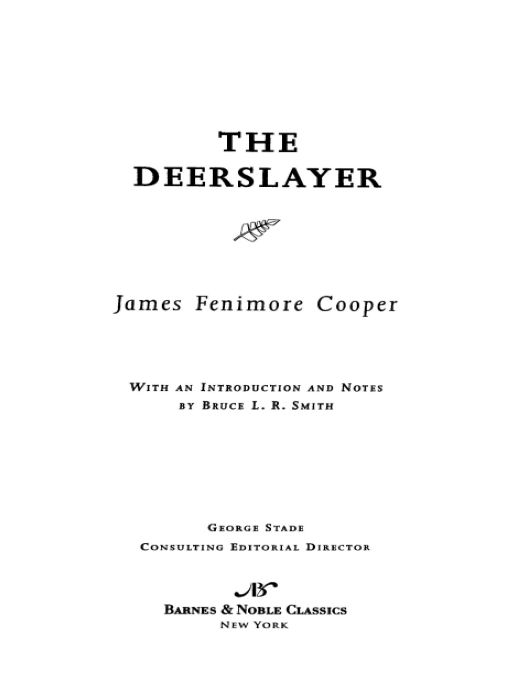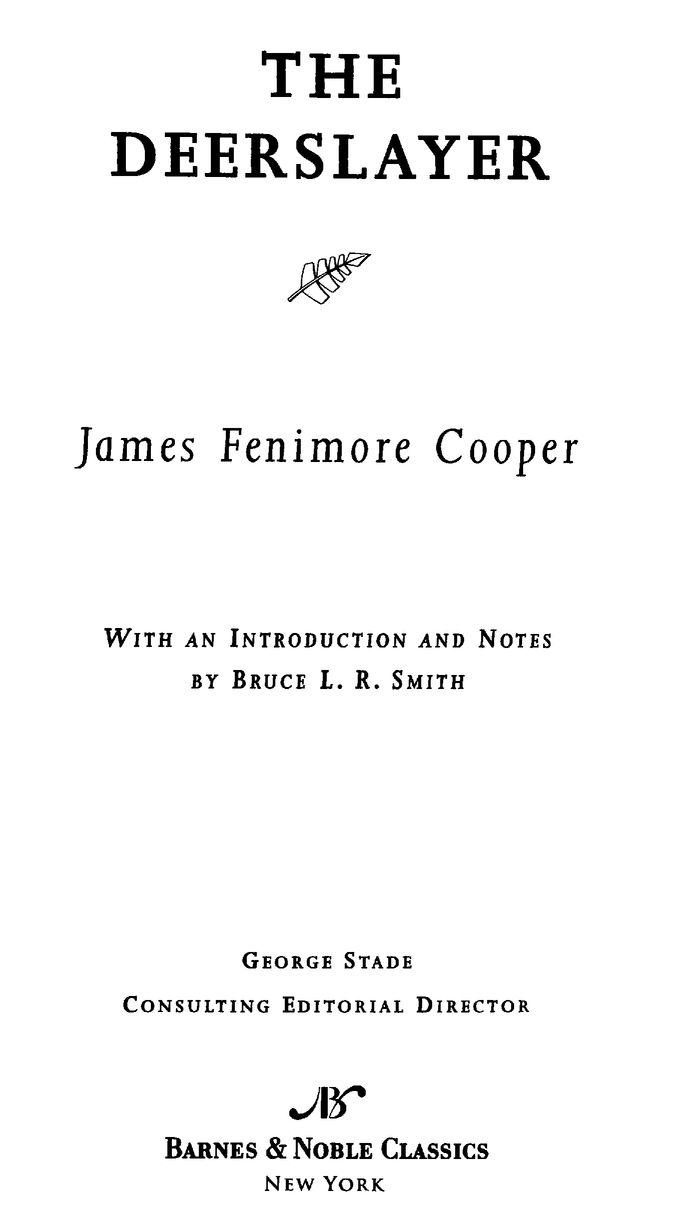Deerslayer (Barnes & Noble Classics Series)
Read Deerslayer (Barnes & Noble Classics Series) Online
Authors: James Fenimore Cooper

BOOK: Deerslayer (Barnes & Noble Classics Series)
5.08Mb size Format: txt, pdf, ePub

Table of Contents
FROM THE PAGES OF
THE DEERSLAYER
THE DEERSLAYER
On all sides, wherever the eye turned, nothing met it but the mirrorlike surface of the lake, the placid view of heaven, and the dense setting of woods. So rich and fleecy were the outlines of the forest, that scarce an opening could be seen, the whole visible earth, from the rounded mountaintop to the water’s edge, presenting one unvaried hue of unbroken verdure.
(page 29)
“They call me Deerslayer, I’ll own; and perhaps I desarve the name, in the way of understanding the creatur’s habits, as well as for sartainty in the aim; but they can’t accuse me of killing an animal when there is no occasion for the meat or the skin. I may be a slayer, it’s true, but I’m no slaughterer.”
(page 49)
Deerslayer—or Hawkeye, as the youth was then first named, for in after years he bore the appellation throughout all that region—Deerslayer took the hand of the savage, whose last breath was drawn in that attitude, gazing in admiration at the countenance of a stranger, who had shown so much readiness, skill, and firmness.
(page 112)
“Natur’ will have its way”
(page 149)
In a bark canoe, they were totally without cover, and Indian discretion was entirely opposed to such a sacrifice of life as would most probably follow any attempt to assault an enemy, entrenched as effectually as the Delaware. Instead of following the ark, therefore, these three warriors inclined towards the eastern shore, keeping at a safe distance from the rifles of Chingachgook.
(page 3 3 0)
“Ought the young to wive with the old—the paleface with the redskin—the Christian with the heathen? It’s ag‘in reason and natur’.”
(page 464)
James Fenimore Cooper



BARNES & NOBLE CLASSICS
NEW
YORK
YORK
Published by Barnes & Noble Books
122 Fifth Avenue
New York, NY 10011
122 Fifth Avenue
New York, NY 10011
The Deerslayer was first published in 1841.
Published in 2005 by Barnes & Noble Classics with new Introduction, Notes,
Biography Chronology, Comments & Questions, and For Further Reading.
Introduction, Notes, and For Further Reading
Copyright © 2005 by Bruce L. R. Smith.
Note on James Fenimore Cooper, The World of James Fenimore Cooper and
The Deerslayer, Comments & Questions, and For Further Reading
Copyright © 2005 by Barnes & Noble, Inc.
Portrait of James Fenimore Cooper provided courtesy of
the Fenimore Art Museum, Cooperstown, New York.
the Fenimore Art Museum, Cooperstown, New York.
All rights reserved. No part of this publication may be reproduced )r transmitted in any form or by any means, electronic or mechanical, ,including photocopy, recording, or any information storage and retrieval system, without the prior written permission of the publisher.
Barnes & Noble Classics and the Barnes & Noble Classics
colophon are trademarks of Barnes & Noble, Inc.
colophon are trademarks of Barnes & Noble, Inc.
The
Deerslayer
Deerslayer
ISBN-13: 978-1-59308-211-6
ISBN-10: 1-59308-211-8
ISBN-10: 1-59308-211-8
eISBN : 97-8-141-14336-0
LC Control Number 2005920752
Produced and published in conjunction with:
Fine Creative Media, Inc.
322 Eighth Avenue
New York, NY 10001
Michael J. Fine, President and Publisher
Printed in the United States of America
QM
3 5 7 9 10 8 6 4 2
JAMES FENIMORE COOPER
James Fenimore Cooper was born September 15, 1789, in Burlington, New Jersey, to William Cooper and Elizabeth Fenimore Cooper. In 1790 the family moved to the frontier country of upstate New York, where William had established a village he called Cooperstown. Although cushioned by wealth and William’s position as a judge, the Coopers found pioneer life to be rugged, and only seven of the thirteen Cooper children survived their early years. Profoundly affected by the challenges of frontier living, James would repeatedly draw on his childhood experience in The Pioneers and many of his other novels.
Cooper was educated by private tutors and at Yale, where he enrolled in 1803; he was expelled in 1805 after setting off an explosion that blew off another student’s dormitory door. As a midshipman in the U.S. Navy, he served at an isolated post on Lake Ontario and in a relatively leisurely assignment in New York City, where he met his future wife, Susan Augusta De Lancey, daughter of a wealthy family. In 1811 he resigned his commission to marry her.
According to family lore, Cooper fell into writing on a dare: One evening he threw down a novel in disgust, saying he could write a better book himself; when Susan challenged him and reminded him that he could barely stand to write a letter, Cooper wrote his first novel, Precaution, published in 1820. Encouraged by favorable reviews, Cooper wrote other books in quick succession and was soon regarded as a major voice in America’s emerging literary tradition. He eventually published thirty-two novels and was the first American to make a living as a professional novelist. Natty Bumppo, who appears in The Deerslayer and the four other Leatherstocking Tales that Cooper published between 1823 and 1841, became one of America’s favorite fictional heroes. Cooper and his family lived in Europe for seven years but returned to America in 1833. Eventually settling in Cooperstown, Cooper remained on the American literary scene as a prolific writer of political tracts, naval histories, and works of fiction. He died in Cooperstown on September 14, 1851.
THE WORLD OF JAMES FENIMORE COOPER AND
THE DEERSLAYER
THE DEERSLAYER
| 1789 | The twelfth of thirteen children, James Cooper is born on September 15 to Judge William Cooper and Elizabeth Fenimore Cooper in Burlington, New Jersey. George Washington is inaugurated president of the United States. |
| 1790 | The Coopers move to the frontier country of upstate New York, where William had founded Cooperstown a few years earlier. In his novels, James will repeatedly draw on his early frontier experiences. |
| 1803 | James Fenimore Cooper enters Yale. |
| 1805 | Cooper is expelled from Yale for blowing off a fellow student’s door with gunpowder. |
| 1806 | Cooper works as a sailor on the Stirling, a merchant vessel. His travels take him to Spain and England. |
| 1808 | Cooper joins the Navy, making Atlantic passages and serving at an isolated post on Lake Ontario. |
| 1811 | Cooper marries Susan Augusta De Lancey, the daughter of a wealthy family in Westchester County, New York. The couple, plagued by financial troubles for the next several years, moves to various towns in New York State before buying a country home near Scarsdale, where they settle with their seven children. |
| 1812 | The United States declares war on Great Britain. |
| 1814 | British troops set fire to Washington, D.C. Francis Scott Key writes “The Star-Spangled Banner.” |
| 1819 | Washington Irving’s tale “Rip Van Winkle” appears. |
| 1820 | After accepting a challenge from his wife to write a book, Cooper pens Precaution, a novel of manners. The Missouri Compromise draws the line between free states and slave states. |
| 1821 | The Spy, a historical romance set during the American Revolution, is published, establishing Cooper as a major literary figure. |
| 1823 | Cooper publishes The Pioneers, the first of the five Leatherstocking Tales, which are set in the 1700s, both before and after the American Revolution, and tell the life of hunter, trapper, and scout Natty Bumppo, known as Leatherstocking. The books follow Natty through various periods of his life, but not in chronological order. |
| 1826 | The Last of the Mohicans, the second Leatherstocking Tale, is published ; Natty aligns himself with Uncas, the Indian of the title, and works as a scout in the British army. The Cooper family moves to Europe, and resides in Paris, Switzerland, Belgium, and England for the next seven years. |
| 1827 | The Prairie, the third novel in the Leatherstocking series, is published ; Natty Bumppo dies among the Indians west of the Mississippi, where he has been driven by the advancing line of pioneers. |
| 1829 | Cooper publishes Notions of the Americans, a reflection on his native land and one of six books he writes while living abroad. |
| 1833 | Cooper returns to the United States. |
| 1834 | Cooper writes A Letter to His Countrymen, in which he criticizes American provincialism and announces his retirement from writing fiction. He publishes Sketches of Switzerland, one of his many travel narratives. |
| 1837 | In response to hostile treatment in the Whig press, Cooper instigates a series of libel suits, in which he remains entangled for years to come. |
| 1838 | Feeling financial strain, Cooper resumes fiction writing with Home as Found and Homeward Bound, which combine adventure with reflections on American society. On the so-called Trail of Tears, thousands of Cherokee Indians die during their removal from ancestral lands in Georgia. |
| 1839 | Cooper publishes The History of the Navy of the United States of America. Edgar Allan Poe’s “The Fall of the House of Usher” is published. |
| 1840 | The Pathfinder, the fourth Leatherstocking book, appears; it takes place in 1760 during the French and Indian War. |
| 1841 | Cooper publishes The Deerslayer, the last of the Leatherstocking Tales; it describes Natty Bumppo’s youth, when Natty and his friend live with the Delaware Indians and fight the Hurons. |
| 1845 | Narrative of the Life of Frederick Douglass, an American Slave, written by Douglass, appears. |
| 1846 | Cooper publishes Lives of Distinguished American Naval Officers. |
| 1850 | Nathaniel Hawthorne’s The Scarlet Letter is published. |
| 1851 | James Fenimore Cooper dies in Cooperstown on September 14, 1851. |
Other books
Closer by Sarah Greyson
Xandrian Stone Book 1: Beginning of a Legend by Breitenstein, Christian Alex
When Blackbirds Sing by Martin Boyd
Maddigan's Fantasia by Margaret Mahy
A Christmas Kiss by Mansfield, Elizabeth;
Spud by Patricia Orvis
The Better Man (Chicago Sisters) by Amy Vastine
Selected Essays of John Berger by John Berger
The Devil Is a Part-Timer!, Vol. 1 by Satoshi Wagahara
Death Gets a Time-Out by Ayelet Waldman